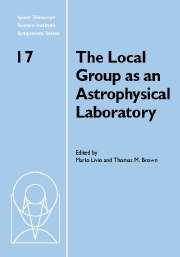 The Local Group as an Astrophysical Laboratory
The Local Group as an Astrophysical Laboratory Published online by Cambridge University Press: 12 May 2010
Status quo and perspectives of standard chemical evolution models of Local Group galaxies are summarized, and what we have learned from them is discussed, as well as what we have not learned yet, and what I think will be learned in the near future. Galactic chemical evolution models have shown that: i) stringent constraints on primordial nucleosynthesis can be derived from the observed Galactic abundances of the light elements; ii) the Milky Way has been accreting external gas from early epochs to the present time; and iii) the vast majority of Galactic halo stars have formed quite rapidly at early epochs. Chemical evolution models for the closest dwarf galaxies, although still uncertain, are expected to become extremely reliable in the immediate future, thanks to the quality of new generation photometric and spectroscopic data which are currently being acquired.
Introduction
The proximity of Local Group galaxies makes them the ideal benchmarks to study galaxy formation and evolution, because they are the only systems where the accuracy and the wealth of observational data allows us to understand them in a sufficiently reliable way. In fact, to understand the evolution of galaxies, astronomers must follow two distinct and complementary approaches: on one hand they must develop theoretical models of galaxy formation, of chemical and dynamical evolution, and on the other hand, they must collect accurate observational data to constrain the models. It is of particular importance to acquire reliable data on chemical abundances, masses and kinematics of galactic components (gas, stars, dark matter), star formation (SF) regimes, and stellar initial mass function (IMF)—quantities that are best derived in nearby systems.
To save this book to your Kindle, first ensure [email protected] is added to your Approved Personal Document E-mail List under your Personal Document Settings on the Manage Your Content and Devices page of your Amazon account. Then enter the ‘name’ part of your Kindle email address below. Find out more about saving to your Kindle.
Note you can select to save to either the @free.kindle.com or @kindle.com variations. ‘@free.kindle.com’ emails are free but can only be saved to your device when it is connected to wi-fi. ‘@kindle.com’ emails can be delivered even when you are not connected to wi-fi, but note that service fees apply.
Find out more about the Kindle Personal Document Service.
To save content items to your account, please confirm that you agree to abide by our usage policies. If this is the first time you use this feature, you will be asked to authorise Cambridge Core to connect with your account. Find out more about saving content to Dropbox.
To save content items to your account, please confirm that you agree to abide by our usage policies. If this is the first time you use this feature, you will be asked to authorise Cambridge Core to connect with your account. Find out more about saving content to Google Drive.